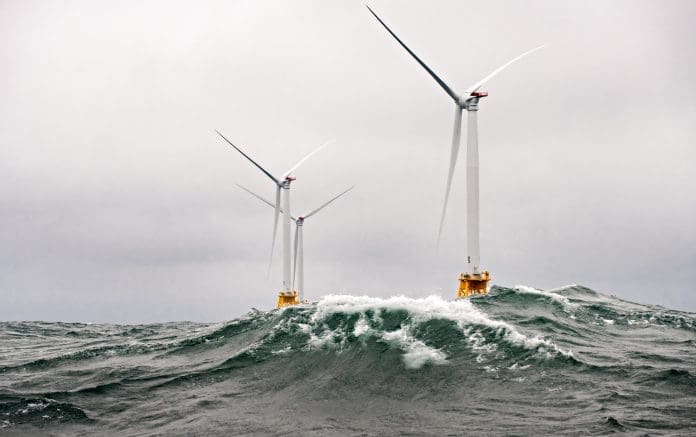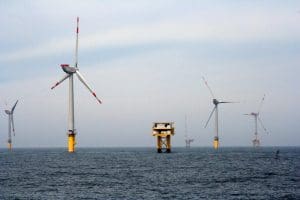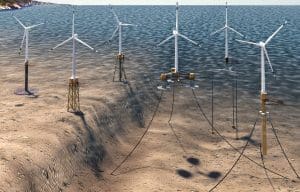
ESG Review sat in on a webinar hosted by Reuters Events titled: “US Offshore Wind: The Road To 30 GW By 2030.” It was jam packed with good information that we wanted to share with you. Before we dive in, we wanted to extend a big thank you to Adam Minkley and Reuters Events for putting together this informative panel, as well as Damian Bednarz, Jennifer Daniels, Adrienne Downey, Derek Stilwell, and Xizhou Zhou for the discussion. Reuters Events hosts several webinars and online events on various topics in the energy industry. Be sure to check them out!
A Quick Primer
On March 29, 2021, a meeting at the White House between Energy Secretary Jennifer Granholm, and other officials formed a national goal to deploy 30 GW of offshore wind by 2030. The effort is expected to generate enough electricity to power more than 10 million American homes and cut 78 million metric tons of carbon dioxide (CO2) emissions. This new goal, with additional Department of Energy (DOE) investments, builds on President Biden’s Executive Order to address the climate crisis and create American jobs by accelerating the deployment of renewable energy on public lands and waters, including through swift interagency action to advance offshore wind.
The goal will spur US$12 billion in capital investment annually, leading to the construction of up to 10 new manufacturing plants for offshore wind turbine components, new ships to install offshore wind turbines, and up to US$500 million in port upgrades. Achieving the 2030 goal would support 77,000 jobs, including more than 44,000 workers employed in offshore wind and nearly 33,000 additional jobs in communities supported by offshore wind activity. It would also unlock a pathway to deploy 110 GW or more of offshore wind by 2050, supporting 135,000 total jobs, including 77,000 in offshore wind and 58,000 in communities with offshore wind activity.
Regulatory Alignment
While the panel recognized the boost that federal backing brings to the offshore wind industry, it was also realistic about the work that needs to be done between aligning state and federal regulation. New Jersey, in particular, has been a model example of what wind developers and investors are looking for. On July 13, 2020, the state of New Jersey released a 510-page document detailing its strategic plan to achieve 7.5 GW of offshore wind by 2035 as a “critical element of meeting the state’s goal of 100% clean energy by 2050.” Attention to detail is vital to the industry because it allows it to make the right supply choices and develop critical infrastructure in a timely manner. It’s encouraging to see New Jersey take point in this regard. The Bureau of Ocean Energy Management (BOEM) has designated 17 offshore wind lease areas along the East Coast, six of which are located off the coast of New Jersey.
“New Jersey’s coastal ocean provides some of the world’s most advantageous conditions for offshore wind development, including good wind resources, favorable ocean seabed and depth, and proximity to large population centers,” said the New Jersey Offshore Wind Strategic Plan. “As the geographic center of this large development area and the owner of many ‘firsts’ in offshore wind, New Jersey will continue to lead and has the unique opportunity to become the nexus of the majority of offshore wind industry in the United States. For example, Governor Murphy recently announced the New Jersey port, which will be the first major new port facility dedicated specifically to service the offshore wind industry.”
Further Coordination
Wind energy is a capital-intensive process requiring coordination between original equipment manufacturers (OEMs), operators, engineering, procurement, and construction (EPC) firms, components manufacturers, and more. Aligning state and federal governments eases the burden on the private sector. But 30 GW by 2030 is a huge ambition that requires communication between these state and federal agencies, as well as financiers, developers, procurement, lease holders, etc.

One big topic of discussion from the panel was the US supply chain and determining whether or not it was ready for this influx in project development. The first commercial offshore wind farm was installed just five years ago off the coast of Rhode Island. Known as the Block Island Wind Farm, it has a capacity of just 30 MW. To go from 30 MW to 30 GW is an unprecedented feat that doesn’t just happen because the federal government wants it to. While all five panelists were optimistic about the ability to reach 30 GW by 2030, and Derek Stilwell even said 300 GW by 2040, the industry simply can’t get complacent. This is why timelines like those provided by New Jersey are so critical. They allow companies to back in financing projections, labor force requirements, and permitting, instead of reacting on the fly.
Cost Of Offshore Vs. Onshore Wind
Technology is one of the driving forces behind reducing the levelized cost of energy (LCOE) for offshore wind projects, which are currently roughly three to five times more expensive than onshore wind projects. While Siemens, Vestas, and other OEMs are developing 10 MW and larger turbines that should reduce costs and drive efficiency, the problem is that there is a lagging factor with implementing new technology. Many of the specs slated for the next three to five years of US projects will need to be centered around existing 6 MW or smaller turbines. The projects can’t simply reinvent the entire spec on the basis of an up-and-coming technology. Therefore, Europe is likely to deploy these larger turbines before the Unite States.

The offshore wind industry doesn’t work in a vacuum. While technology can be helpful, it isn’t everything. It has only been five years since Block Island, and already we’ve seen costs decrease dramatically. The panel’s consensus estimate was that costs will fall further independent of new technology thanks to economies of scale, supply chain improvements, and experience. As experience grows, so does the chance to encourage wind energy education through college programs, whether that’s science, technology, engineering, and math (STEM) or business. Wind projects can be messy as different players balance getting power to the grid, connecting with power markers, etc. However, the industry can’t just wait for the cost curve to come down. It needs to get better with every project that comes online.
Protecting Coastal Communities
Coastal communities are on the front lines of offshore wind development. Projects need to be sensitive to the needs of these communities and be a positive influence on their welfare, not just use their real estate for financial gain. Therefore, the panel advocated including coastal communities in the conversation for wind project development. How will the communities benefit? Will it create jobs? How can companies get involved in the communities they are working with? The reality is that many of these communities, whether in New Jersey or California, are about to be impacted by the offshore wind industry for decades if not centuries to come. Some of them will be changed forever. It wasn’t long ago that beach communities lobbied against offshore wind development on the grounds that it could interfere with tourism.
Aside from efforts by the private industry, the DOE and the Department of Commerce jointly announced a new partnership through the Northeast Sea Grant program that will fund US$1.25 million in research into the impacts of ocean-based renewable energy — such as offshore wind, wave, current, and tidal energy — on the fishing industry and Northeastern coastal communities. Similar to confrontation between landowners and pipeline developers in the oil and gas industry, or Kansas citizens advocating for the passing of Senate Bill 279, there will always be some form of disagreement between citizens and industry. The offshore industry has a chance to do things the right way, but it can’t please everyone.

East Coast Vs. West Coast
Another interesting takeaway from the panel was the differences between East Coast and West Coast offshore wind development. Jennifer Daniels, a geologist on the panel, noted that east coast sediment conditions are better and the water is shallower than the west coast. The west coast’s deeper water and traditional foundations are not conducive to existing offshore wind technology. Therefore, Daniels predicts that floating offshore wind offers the most potential off the west coast. The west coast’s advantage is that cities like Long Beach, California are massive hubs for international commerce and have experience with offshore oil and gas activities. Pivoting to floating offshore wind would be easier in some ways than developing completely new supply chains on the east coast.
















